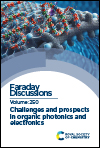Spinless formulation of linearized adiabatic connection approximation and its comparison with second order N-electron valence state perturbation theory
Abstract
The adiabatic connection (AC) approximation, along with its linearized variant AC0, was introduced as a method of obtaining dynamic correlation energy. When using a complete active space self-consistent field (CASSCF) wave function as a reference, the AC0 approximation is considered one of the most efficient multi-reference perturbation theories. It only involves the use of 1$^{st}$- and 2$^{nd}$-order reduced density matrices. However, some numerical results have indicated that the excitation energies predicted by AC0 are not as reliable as those from the second-order N-electron valence state perturbation theory (NEVPT2). In this study, we develop a spinless formulation of AC0 based on the Dyall Hamiltonian and provide a detailed comparison between AC0 and NEVPT2 approaches. We demonstrate the components within the correlation energy expressions that are common to both methods and those unique to either AC0 or NEVPT2. We investigate the role of the terms exclusive to NEVPT2 and explore the possibility of enhancing AC0's performance in this regard.
- This article is part of the themed collection: Correlated electronic structure

 Please wait while we load your content...
Please wait while we load your content...